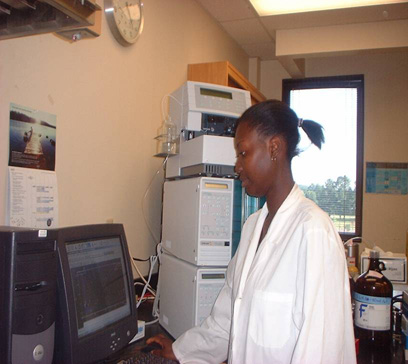Preparation of samples
Preparation of Mobile Phase
Statistical Analysis
 0.05.
0.05.
Paper 92A-8. Presented at the Institute of Food Technologists Annual Meeting, Chicago, IL, July 15, 2003.
Blanching is an effective way of preserving fruits and vegetables. However, it has been shown that conventional
boiling water blanching of vegetables results in the leaching of water-soluble vitamins. This experiment was
designed to determine the effectiveness of different blanching methods on the retention of selected water-soluble
vitamins in turnip greens. The objective was to employ a HPLC method in the determination of the level of
selected water-soluble vitamins in turnip greens that were blanched using conventional and microwave blanching
methods. Turnip greens (Brassica rapa) were purchased from a local supermarket. They were thoroughly washed,
chopped and separated into three treatment groups including unblanched (UB) which served as the control;
boiling water blanched (BWB); and microwave (1300 watts) blanched (MWB). A 100 gm sample from each
treatment group was subjected to blanching treatment (according to designation) for 5 minutes. The
samples were cooled in iced-water and an extract prepared using a modification of a method previously
described by Russell (1986). A 10µl sample (in duplicate) from each treatment extract was separately
injected in a Varian ® HPLC with a C18 column and a UV detector set at 272nm. Concentrations of
ascorbic acid, folic acid, thiamin and riboflavin were determined using external standards.
The result showed that, compared to control samples, BWB lost 16% ascorbic acid, and 100% folic acid,
thiamin and riboflavin while MWB lost 28.8% ascorbic acid, 25.7% folic acid 16.9% thiamin and 7.2% riboflavin.
The results indicate that MWB is more effective in the retaining the selected water-soluble vitamins with the
exception of ascorbic acid. This is also in congruence with earlier findings indication that microwave
blanching is more effective in retaining nutrients in vegetables.
Blanching is the process of exposing vegetables or fruits to high temperature for a short period of time. It is done not only to prolong the self-life of vegetables by inactivate the enzymes responsible for browning (lipoxygenase and peroxidase) but also improves both color and flavor. Proper blanching is important as under-blanching is ineffective in inactivating the enzymes that reduce the quality while over-blanching can result in overall quality reduction and the leaching of essential vitamins and minerals. Conventionally blanching is done through the use of boiling water or steam, however microwave blanching may be a suitable alternative which could lead to improved overall quality and retention of essential minerals and vitamins. However the high cost of the equipment made the use uncommon in food industries. Boiling water blanching is most used at home. It is easy, simple and inexpensive, but has highest potential of leaching water-soluble vitamins and minerals compared to other methods. Convectional steam blanching is currently the most commonly used method in the food industry today. It is relatively inexpensive and retains minerals and water-soluble vitamins over-boiling water blanching.
Preparation of samples
Preparation of Mobile Phase
Statistical Analysis
 0.05.
0.05.

| Ascorbic Acid | Folic Acid | Thiamine | Riboflavin | |
|---|---|---|---|---|
| Control | 20.0 |
536.0 |
3.06 |
14.0 |
| Microwave blanching | 14.2 |
398.0 |
2.54 |
13.0 |
| Boiling water blanching | 0.17 |
0.01 |
0.01 |
0.01 |

This material is based upon work supported by the Cooperative State Research, Education, and Extension Service, U.S. Department of Agriculture, under Agreement No. 00-51110-9762.
Document Use:
Permission is granted to reproduce these materials in whole or in part for educational purposes only (not for profit beyond the cost of reproduction) provided the authors and Alabama A&M University receive acknowledgment and this notice is included:
Reprinted with permission of Alabama A&M University. M. A. OSINBOYEJO, L. T. Walker, S. Ogutu, and M. Verghese. 2003. Effects of microwave blanching vs. boiling water blanching on retention of selected water-soluble vitamins in turnip greens using HPLC. Normal, AL: Alabama A&M University, Food and Animal Sciences Department.
References to commercials products, services, and information is made with the understanding that no discrimination is intended and no endorsement by the University of Georgia, U.S. Department of Agriculture and supporting organizations is implied. This information is provided for the educational information and convenience of the reader.
The University of Georgia and Ft. Valley State University, the U.S. Department of Agriculture and counties of the state cooperating. The Cooperative Extension Service, the University of Georgia College of Agricultural and Environmental Sciences offers educational programs, assistance and materials to all people without regard to race, color, national origin, age, sex or disability. An Equal Opportunity Employer/Affirmative Action Organization Committed to a Diverse Work Force.
| Contacts: | |
| National Center for Home Food Preservation | Lloyd T. Walker, Ph.D., Chair |
| 208 Hoke Smith Annex | Food and Animal Sciences Dept. |
| The University of Georgia | Alabama A&M University |
| Athens, GA 30602-4356 | PO Box 1628 |
| Normal, AL 35762-1628 | |
| Tel: (706) 542-3773 | Tel: (256) 372-4166 |
| Fax: (706) 542-1979 | Fax: (256) 372-5432 |
| Email: lloyd.walker@email.aamu.edu | |
| Web: http://www.homefoodpreservation.com |